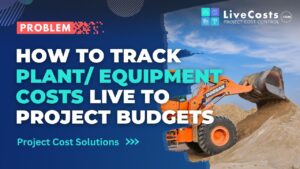Every day, a construction company has to make a decision: how do I get the most out of this construction project?
You may not realise it, but as a construction company you’re probably sitting on a gold mine of practical insights about your business.
But we’re all human. That’s why construction companies around the world are embracing alternative ways of looking at their project’s success that we as humans can’t see, but construction data analytics software might catch.
Construction data analytics software lets construction companies examine and analyse project and company data so we can extract insights, and inform decision-making.
In the context of construction accounting software, data analytics can be used to help construction companies better understand their financial data and identify trends and patterns that may be hidden within the data.
Here’s the good news: there are lots of ways to do it. Construction companies now have a variety of data analytics tools at their disposal to analyse their financial data, including construction cost management software, business intelligence (BI) software, and specialised analytics platforms.
These tools can allow construction companies to visualise their data in various ways, such as charts, graphs, and tables, and to perform statistical analysis on the data.
Here we’ll look at the four most practical ways that construction companies can use data analytics software to drive growth.
1. Identify Cost Drivers: Data analytics can help construction companies identify the factors that are driving their costs, allowing them to take targeted action to reduce costs and improve profitability.
2. Monitor Financial Performance: Data analytics can help construction companies track their financial performance over time, allowing them to identify trends and make adjustments as needed.
3. Forecast Future Performance: Data analytics can be used to forecast future financial performance, helping construction companies make informed decisions about their business.
4. Identify Opportunities for Improvement: Data analytics can help construction companies identify areas of their business that may be underperforming, or where there is room for improvement, allowing them to take targeted action to improve those areas.
Overall, data analytics can be a powerful tool for construction companies that want to improve their accounting processes and operations. By using data analytics to extract insights from their financial data, construction companies can make more informed decisions about their business and improve their financial performance.
1. How To Use Data Analytics to Identify Construction Cost Drivers
You probably have a good sense of what drives the biggest costs in your construction business: materials, labour, equipment, and overhead expenses.
But as in any business, the devil is in the detail. What costs you more in your current project that maybe was cheaper in your previous project? Was there an additional cost to a project phase, such as a delay, that might not be so clear from the invoice?
Every construction project has hidden costs, and that’s where data analytics software for construction companies can give you real insight into costs that you didn’t know were there – or were so high.
At LiveCosts, we call this process Identifying Cost Drivers. It reveals to construction companies the key factors that are contributing to their overall costs, and it allows them to take targeted action to reduce those costs.
By analysing their financial data, your construction company can identify the specific cost drivers that are having the greatest impact on their costs and take action to address those drivers. Either on the fly in a current project, or to take those learnings into their next project.
For example, if your construction company is analysing its financial data and finds that materials costs are a major cost driver, it may consider taking action to reduce those costs, such as negotiating better prices with suppliers or finding more cost-effective materials.
Similarly, if labour costs are a major cost driver, the company may consider ways to reduce labour costs, such as improving productivity or finding more cost-effective labour sources.
These insights pair well with complimentary construction softwares. Now that you can visualise the true detail of your costs, software that finds the best materials prices, or more accurately tracks and predicts labour costs, can be introduced to protect your bottom line from unnecessary construction costs.
Overall, identifying cost drivers can be a powerful way for construction companies to understand their costs and take targeted action to reduce those costs. By using data analytics to identify cost drivers and taking action to address those drivers, construction companies can improve their financial performance and increase their profitability.
2. How To Monitor Financial Performance with Construction Data Analytics
Monitoring financial performance is a data-driven process where your construction company tracks and analyses your company’s financial data over time to understand its financial performance.
As a construction company, you probably track a few key financial metrics: revenue, profits, expenses, and cash flow.
Add in construction data analytics software, and now you can analyse trends and patterns in that data to your company’s competitive advantage.
For example, a construction company might track its revenue over time to understand how it has changed, or it might analyse its expenses to identify areas where costs are increasing or decreasing.
Are you making more from one type of project than you used to? Or has a former pillar of your business become more expensive than it used to be, despite top-level revenue being the same?
Furthermore, when you monitor the financial performance of your construction company, it can help you make new informed decisions about your business and identify new opportunities for improvement.
For example, if a construction company is monitoring its financial performance and notices that its profits are declining, it might investigate the reasons for the decline and take action to address any underlying issues.
Similarly, if a construction company is monitoring its financial performance and notices that its revenue is increasing, it might consider expanding its operations or investing in new projects.
Overall, monitoring financial performance can be a valuable tool for construction companies looking to improve their financial performance and make informed decisions about their business. By tracking and analysing their financial data over time, construction companies can identify trends and patterns and take action to address any underlying issues.
3. How To Forecast Future Performance
If you’re reading this, it’s because you want your construction company to grow and grow, and with the minimum amount of uncertainty possible. The more you know, the better you can strategise your company’s future.
Often, the best indicator of future performance is past performance – but what level of detail do you truly have about your company’s past performance?
And even with that detail, how can we use it as data to predict the future?
Construction companies like yours can forecast their future performance by using granular historical data to predict, to a high level of detail, future revenue, future profits, and future expenses.
And most importantly: future cash flow.
For example, a construction company might use data analytics to predict how its revenue is likely to change over the next year, based on trends in its historical data and assumptions about future economic conditions.
By predicting future financial performance, construction companies can better understand the potential outcomes of different decisions and take action to optimise their financial performance.
In another example, a construction company might agree to take on a project because they believe their cash flow at that time will be sufficient to manage the project profitably. But without proper construction data analytics, such an assumption is dangerous. Many a construction company has found themselves on the hook for costs they predicted they could handle out of cash flow, but it turns out that they can’t.
Finally, one of the biggest benefits to any construction company that forecasting brings is to reduce the uncertainty around the true profits of your next project. As such, it’s best for construction companies to use a range of data and methods when forecasting their future performance.
4. How Construction Companies Can Identify Opportunities for Improvement
When we talk about construction companies using data analytics to identify opportunities for improvement, we mean using historical data that’s based on their current way of doing business.
This allows construction companies like yours to discover new ways to save on project costs, but usually with only slight changes to methodology. And when we pair these insights with construction accounting software, the cost-savings can be substantial.
The three easiest ways to use construction data analytics to identify opportunities for improvement are: where costs can be reduced; where efficiency can be improved, and where profits can be increased.
For example, a construction company might use data analytics to identify areas where it is spending more on materials than necessary, or where it is experiencing delays or other issues that are impacting productivity.
You might be focused on the simple profit/loss of time and materials vs revenue, but how much are you spending on site waste? Have your energy bills gone up? Data analytics often reveals opportunities to combine two processes into one, meaning you get more profit from each project.
For example, a construction company might negotiate better prices with suppliers to reduce material costs, or it might implement new processes or technologies to improve efficiency.
Overall, identifying opportunities for improvement is a valuable tool for construction companies looking to optimise their financial performance and make informed decisions about their business. By analysing their financial data and identifying areas where there is room for improvement, construction companies can take action to address those issues and improve their performance.



